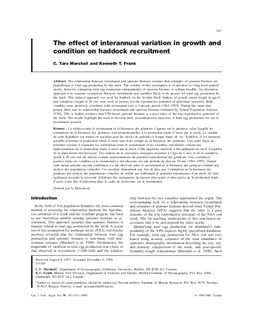The effect of interannual variation in growth and condition on haddock recruitment
Journal article, Peer reviewed
Permanent lenke
http://hdl.handle.net/11250/108245Utgivelsesdato
1999Metadata
Vis full innførselSamlinger
- Articles [3012]
Originalversjon
http://dx.doi.org/10.1139/f99-019Sammendrag
The relationship between recruitment and spawner biomass assumes that estimates of spawner biomass are
proportional to total egg production by the stock. The validity of this assumption is in question for long-lived gadoid
stocks; however, estimating total egg production independently of spawner biomass is seldom feasible. An alternative
approach is to examine correlations between recruitment and variables likely to be proxies for total egg production by
the stock. This indirect approach was used for haddock on the Scotian Shelf. Indices of growth (mean length at age-4)
and condition (weight at 50 cm) were used as proxies for the reproductive potential of individual spawners. Both
variables were positively correlated with recruitment over a 3-decade period (1964–1995). During the same time
period, there was no relationship between recruitment and spawner biomass estimated by Virtual Population Analysis
(VPA). This is further evidence that VPA-based spawner biomass is a poor index of the true reproductive potential of
the stock. The results highlight the need to develop more accurate/precise measures of total egg production for use in
recruitment research.
